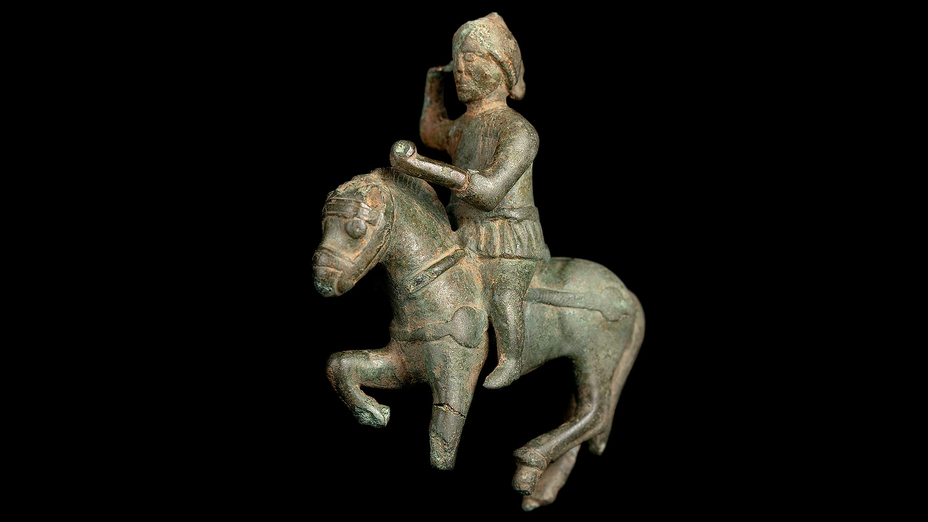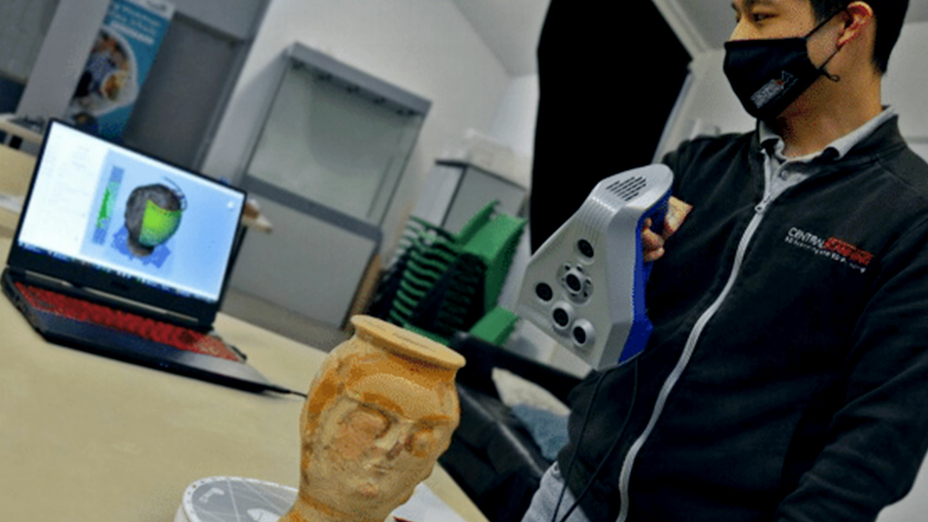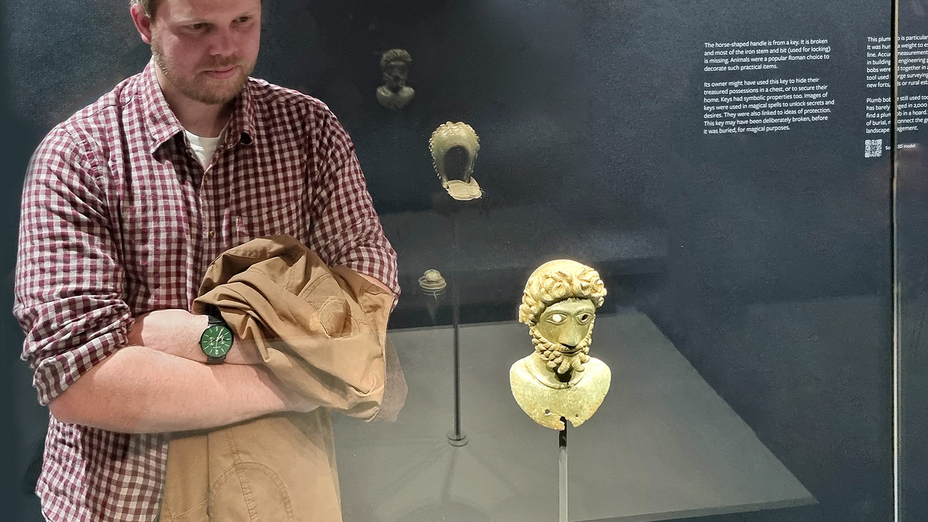3D scanning Yorkshire Museum’s Ryedale Hoard with Artec Space Spider
Challenge:After acquiring the 1,800-year-old Roman-Britain Ryedale Hoard collection, the Yorkshire Museum needed a way to quickly and non-destructively create historically accurate 3D digital twins of the four irreplaceable objects, in order to share them with visitors near and far using the latest in curatorial innovation.
Solution:Artec Space Spider, Artec Studio, 3D Systems ColorJet printer
Results:Each of the four Ryedale Hoard artifacts was safely 3D scanned in less than five minutes. In under an hour, all the scanning and processing was done, resulting in four breathtaking 3D digital twins of the entire collection. In contrast, the traditional method of photogrammetry would have demanded significant amounts of handling and positioning, an entire day to carry out the capture process, and an additional day for creating 3D models from the photos.
They stopped digging when they saw a glimpse of bronze. At first, they thought it was the edge of a Bronze Age axe head. Minutes later, as they lifted the small bust of Marcus Aurelius from a hole in a farmer’s field in Ryedale, England, metal detectorists Mark Didlick and James Spark held their breath.

Marcus Aurelius bronze bust, minutes after being discovered by metal detectorists. Photo: Mark Didlick
For what seemed like minutes, neither could speak, as they gently brushed away the few chunks of soil from the ancient emperor’s face.
Thebustwas their second find of the day. They kept searching the area. When they were done, besides the bust, they had unearthed three other objects: aplumb bob, astatuetteof the Roman god Mars, and a horse-headknife handle.
Didlick sent several photos to former archaeologist Brian Walker, who, astonished by the find, said that these were very likely Roman-era artifacts dating back to the 2ndcentury AD.
From farmer’s field to Yorkshire Museum exhibit hall
In the weeks ahead, the 1,800-year-old collection – one of the finest from Roman Britain – was authenticated and namedThe Ryedale Hoard. It was later acquired by the York Museums Trust and has since gone on display at the Yorkshire Museum.
According to Yorkshire Museum senior curator Andrew Woods, “Never before has this number of remarkably fine, Roman-era artifacts been found in the UK at one time, in one place. All of these objects exhibit unbelievably fine workmanship. And we believe that they were made right here in Britain, around the very peak of the Roman Empire.”

Ryedale Hoard bronze bust of the Roman Emperor Marcus Aurelius. Image courtesy of York Museums Trust
Originally designed to sit atop the scepter of a priest of the Roman imperial cult, this finely made bust of Marcus Aurelius doubtlessly saw frequent use in ceremonies and rituals honoring the emperor.
The artist who crafted this extraordinary piece likely was local to Britain and never saw the emperor in person, instead working from existing sculptures and depictions on coins.

Yorkshire Museum senior curator Andrew Woods with Ryedale Hoard Mars on horseback statuette. Image courtesy of York Museums Trust, copyright Charlotte Graham Photography
Across the empire, the Roman god Mars was often portrayed as a warrior on horseback. In this figurine, the ancient deity is fiercely galloping into battle, yet the spear and shield that he once wielded have since been lost to the centuries.

Ryedale Hoard horse-shaped knife handle. Image courtesy of York Museums Trust
Animals were a popular choice for adorning everyday objects in Roman times. This horse-shaped handle originally held a knife, which might have purposely been broken off before burial.
With a design that has changed little in the past 2,000 years, the Ryedale Hoard plumb bob would have played an important role in Roman Britain, making accurate measurements for new roads, forts, and settlements.

Ryedale Roman Hoard. Image courtesy of York Museums Trust
Researchers have concluded that these objects were buried in the late 2ndcentury AD as some type of sacrifice to the gods, yet studies are still underway to achieve a clearer picture of both the importance of these priceless artifacts as well as why they were deposited in the earth in such a manner.
Creating digital twins of the Ryedale Hoard
As a crucial part of the Yorkshire Museum’s focus on being a leader in the digital space, building an online presence, and sharing its collections around the world, they decided to capture the entire Ryedale Hoard collection in 3D.
In the past, they accomplished such projects mostly via photogrammetry, in partnership withHeritage360at the University of York.
But due to the nature of photogrammetry, including the lengthy photography sessions (when using a single-camera setup) and the considerable amount of handling required to position and reposition each object being captured, such projects needed to be scheduled with curators weeks, if not months, in advance.

Artec Space Spider 3D scan of Marcus Aurelius bust. Image courtesy of Heritage360
In the words of Heritage360’s Patrick Gibbs, “There’s so much involved in the capture of historic artifacts. It’s not simply a case of bringing it out and capturing it in a few minutes. Because of the potential risks to the objects and the need for a curator to be there, we need to liaise with the museum and work out the best and safest way to organize everything.”
He continued, “With our single-camera photogrammetry setup, we may have to spend two days working with an artifact, just to make sure everything has been captured and we have everything we need. This can take two to three months to schedule, because of all the logistical challenges involved.”
If they continued down the same path, digitizing the Yorkshire Museum’s Ryedale Bronze collection would have entailed months to organize and carry out. Not to mention the museum’s thousands of other artifacts awaiting digital transformation.

Ryedale Hoard Mars on horseback statuette. Image courtesy of York Museums Trust
The search for an alternative to traditional photogrammetry
That’s what compelled Gibbs and his digital technology specialist James Osborn to explore the market for other possibilities. Their online research led them to Artec AmbassadorCentral Scanning, experts in 3D scanning for cultural preservation and a range of other industries.
Even before the first demo was finished, Gibbs and Osborn knew they had found the right solution: theArtec Space Spider.
The Space Spider is a handheld 3D scanner that’s been a worldwide favorite among archaeologists, cultural heritage specialists, and many others for years.
With its ability to capture even the most intricate details of objects with submillimeter accuracy as well as vivid 3D color reproduction, without the need for targets or sprays, Space Spider can deliver scans for use in online and in-museum exhibitions, digital repositories, 3D-printed educational models, and beyond.

Alex Chung of Central Scanning capturing a Roman head pot with Artec Space Spider. Image courtesy of Heritage360
Addressing how the scanner has helped with the Yorkshire Museum’s plans, Woods said, “What’s highly important to us is to offer visitors something they won’t necessarily get even if they walk into our museum.”
Woods explained further, “With absolutely no risk to the objects themselves, you will be able to virtually pick them up, turn them around, explore them, and along with labels and notes from a curator, drawing attention to potentially dozens of fascinating facts or stories connected with each object, your experience will be both highly memorable and entirely your own.”
The entire Ryedale Hoard 3D scanned in under an hour
When it came time to 3D scan the Ryedale Bronze collection with their new Space Spider, Gibbs and Osborn were in for a surprise; so was the curator assisting with the project.
One by one, each of the four artifacts was positioned on anArtec Turntableand scanned separately in less than five minutes from start to finish. Just 10 minutes later, and the scan processing inArtec Studio softwarehad transformed the scans into a stunning 3D model of the object.
“With absolutely no risk to the objects themselves, you will be able to virtually pick them up, turn them around, and explore them. Your experience will be both highly memorable and entirely your own.”
The total time needed for setup, scanning, and processing all the objects into their respective 3D models was less than one hour. In contrast with their previous photogrammetry work, the comparison is dramatic.

Space Spider scan of Marcus Aurelius bust in Artec Studio software. Image courtesy of Heritage360
Commenting on this, Osborn said, “It would’ve taken a full day to just capture the objects using photogrammetry. And then if the light changed even slightly during the session, we’d have to ask the curator to bring out the object again, to redo that photo using the exact lighting conditions. Maybe that’s not even possible the same day. So you have to compensate for this by taking loads of extra photos, hoping all of them turn out perfectly, although you won’t know that till the processing stage.”
He elaborated, saying, “Once you start processing all the photos, you’re looking at another day, assuming everything goes according to plan. So, considering everything, what took us an hour with Space Spider would’ve taken us nearly two days if we had used photogrammetry, without the added risk from having to maneuver every object into all the positions with a variety of small props that photogrammetry demands.”
Transforming the scans into exceptional 3D models
For processing the scans in Artec Studio, their workflow is simple and straightforward. First they use base removal, to delete any unwanted data from beneath the object. Once that’s done, they align the scans, bringing all the geometry together.
From there, they apply sharp fusion at 0.1 mm, and when exporting 3D models for online viewing, they reduce the poly count to optimize file size and display speed.

Space Spider scan of Mars on horseback statuette in Artec Studio software. Image courtesy of Heritage360
The resulting 3D models are now being used both within the Yorkshire Museum as well as online. For the former, QR codes linked to corresponding Sketchfab models have been placed alongside the displays holding the original artifacts, allowing museum visitors to boost their engagement up to the next level.
How the Yorkshire Museum shares 3D content around the world
And the museum isn’t stopping there. They’re also aiming to embed these 3D models in places such as Wikimedia Commons, where they will be viewed millions of times every week.
Woods explained the reasoning behind this. “In this way, we’ll be taking our collections to people around the world who would probably never have a chance to see them otherwise, much less visit our museum,” he said. “By putting these 3D scans where people will already be, we’ll be able to connect with them far more easily.”
The Yorkshire Museum plans to offer the 3D models of the Ryedale Bronzes as freely available for download, both in low-res and high-res versions. Teachers, artists, researchers, and others will be welcome to download and use the scans however they’d like.
Magnificent 3D-printed replicas for education
As part of their educational outreach efforts, the Yorkshire Museum and Heritage360 decided to create 3D-printed “handling” versions of the Ryedale Bronzes from the Space Spider scans, for use with visiting schoolchildren.

3D-printed, hand-painted Ryedale Hoard. Image courtesy of York Museums Trust
Not yet having the expertise and technology for this in-house, they reached out to the 3D digital heritage specialist Steven Dey atThinkSee3D. Since the firm’s founding in 2015, Dey has created hundreds of digitally produced, historically accurate replicas for museums and other clients in the UK and beyond.
Once Dey had received the 3D models (as OBJ files) of the Ryedale Bronzes from Heritage360, the 3D printing took about three hours from start to finish, with all four objects being printed at once on a 3D Systems ColorJet Printer, using a gypsum core.
A masterfully done aging process for achieving that ancient look
The base color was applied as an undercoat, and the objects were then given an epoxy surface coating with a bronze powder dusting while still sticky. After the epoxy-powder had set, the objects were polished to achieve a shiny bronze appearance, as if they were new.
From there, they were artificially aged, using a combination of spray paints and waxes, to lend them a verdigris look, strikingly similar to that of the original objects.

3D-printed, hand-painted replica of Marcus Aurelius bust. Image courtesy of ThinkSee3D
Now students can actually pick up and explore these beautiful, faithfully reproduced replicas for themselves, making them an unforgettable accompaniment to textbook lessons focused on this important chapter of history.
Looking forward to 3D scanning the past
After the success of digitizing the Ryedale Hoard collection, the Yorkshire Museum has now set its sights on doing the same for its other collections, which include thousands of fascinating objects such as swords and jewels, extinct Moa, Auks, and dinosaurs, an intricate Roman-Britain-era floor mosaic and burial casts, and much more.

Heritage360’s James Osborn visiting the Ryedale Hoard exhibit at the Yorkshire Museum. Image courtesy of Heritage360
Woods commented on the difference that3D scanninghas made: “Good museum curation is not simply about telling people things, but really making it possible for people of all ages to have a journey of their own self-exploration, where they discover unforgettable things about these objects in their own personal ways.”
He continued, saying, “And this is what 3D scanning with Artec has allowed us to do here.”
Scanners behind the story
Try out the world's leading handheld 3D scanners.




